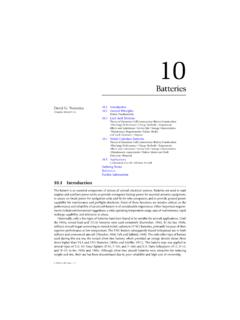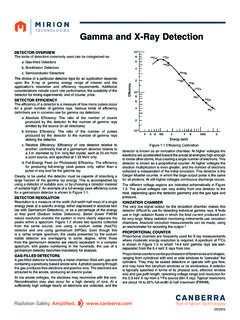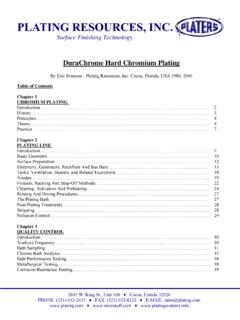Transcription of Method 6860 - Perchlorate in Water, Soils and Solid …
1 6860 - 1 Revision 0 January 2007 Method 6860 Perchlorate IN WATER, Soils AND Solid WASTES USING ION chromatography / electrospray ionization / mass spectrometry (IC/ESI/MS OR IC/ESI/MS/MS) SW-846 is not intended to be an analytical training manual. Therefore, Method procedures are written based on the assumption that they will be performed by analysts who are formally trained in at least the basic principles of chemical analysis and in the use of the subject technology.
2 In addition, SW-846 methods, with the exception of required Method use for the analysis of Method -defined parameters, are intended to be guidance methods which contain general information on how to perform an analytical procedure or technique which a laboratory can use as a basic starting point for generating its own detailed Standard Operating Procedure (SOP), either for its own general use or for a specific project application. The performance data included in this Method are for guidance purposes only, and are not intended to be and must not be used as absolute QC acceptance criteria for purposes of laboratory accreditation.
3 SCOPE AND APPLICATION This Method uses ion chromatography (IC) coupled with electrospray ionization (ESI) mass spectrometry (MS) or tandem mass spectrometry (MS/MS) for the determination of Perchlorate in surface water, groundwater, salt water and soil (See Refs. 1-3). The following analyte has been determined by this Method : Analyte CAS ClO4- 14797-73-0 aChemical Abstract Service Registry Number This Method has not been fully validated for complex matrices, such as wastewater treatment sludges, using the recommended extraction procedure.
4 Additional studies are necessary to confirm whether alternate extraction approaches are able to provide more efficient Perchlorate recoveries. Prior to employing this Method , analysts are advised to consult the base Method for each type of procedure that may be employed in the overall analysis ( , Methods 3600 and 8000) for additional information on quality control procedures, development of QC acceptance criteria, calculations, and general guidance. Analysts also should consult the disclaimer statement at the front of the manual and the information in Chapter Two for guidance on the intended flexibility in the choice of methods, apparatus, materials, reagents, and supplies, and on the responsibilities of the analyst for demonstrating that the techniques employed are appropriate for the analytes of interest, in the matrix of interest, and at the levels of concern.
5 6860 - 2 Revision 0 January 2007 In addition, analysts and data users are advised that, except where explicitly specified in a regulation, the use of SW-846 methods is not mandatory in response to Federal testing requirements. The information contained in this Method is provided by EPA as guidance to be used by the analyst and the regulated community in making judgments necessary to generate results that meet the data quality objectives for the intended application.
6 Use of this Method is restricted to use by, or under supervision of, personnel appropriately experienced and properly trained in the use of IC/MS or IC/MS/MS instrumentation and skilled in the interpretation of mass spectra. Each analyst must demonstrate the ability to generate acceptable results with this Method . SUMMARY OF Method Perchlorate is separated, detected and quantified using one of three instrument system options as described in Secs. IC/MS An appropriate volume of sample or sample extract is introduced into an IC/MS instrument.
7 Perchlorate (ClO4-) is separated by IC from the sample matrix. The IC effluent is ionized in the electrospray source and transferred to the mass spectrometer where the Perchlorate is detected and quantified using mass -to-charge (m/z) ratios 99 (ClO4-), 101 (37 ClO4-) and 107 (Cl18O4-). Quantitation is performed using m/z 99 and internal standard calibration. Isotopically-labeled Perchlorate (Cl18O4-), serves as an internal recovery and calibration standard (IRCS) to correct for Perchlorate loss from the sample preparation procedure as well as during IC/MS analysis.
8 The 99/101 isotopic ratio reflects the isotopic ratio of naturally occurring 35Cl/37Cl and is used for additional confirmation of Perchlorate identification. IC/MS/MS Following IC separation and ionization , the Perchlorate is isolated in the first mass spectrometer and transferred to a collision cell for fragmentation. The resulting fragments 83 (ClO3-), 85 (37 ClO3-) and 89 (Cl18O3-) are introduced into the second mass spectrometer where they are detected and quantified. IC/MS with fragmentation This analysis option is similar to Sec.
9 , except that the separated Perchlorate is partially fragmented and detected by MS using m/z ratios 83 (ClO3-), 85 (37 ClO3-) and 89 (Cl18O3-). Matrix diversion may be used to direct early-eluting, matrix components to waste prior to the introduction of Perchlorate into the mass spectrometer in order to minimize the accumulation of salt deposits in the electrospray source and mass spectrometer (Sec. ). A conductivity suppressor (Sec. ) may be used to replace cations, such as potassium ion, with hydronium ion in the post-column eluent stream in order to minimize salt accumulation in the electrospray source and mass spectrometer.
10 A conductivity detector (Sec. ) may also be used in order to monitor the conductivity of the eluent stream entering the mass spectrometer. Just prior to introduction into the mass spectrometer, the addition of solvent may be necessary to ensure adequate sample ionization in the electrospray source (Sec. ) Solids are first extracted prior to analysis using reagent water (Sec. ). The filtered extracts are then analyzed by IC/MS or IC/MS/MS as described in Sec. 6860 - 3 Revision 0 January 2007 DEFINITIONS Refer to Chapter One, Chapter Three, and the manufacturer's instructions for definitions that may be relevant to this procedure.














